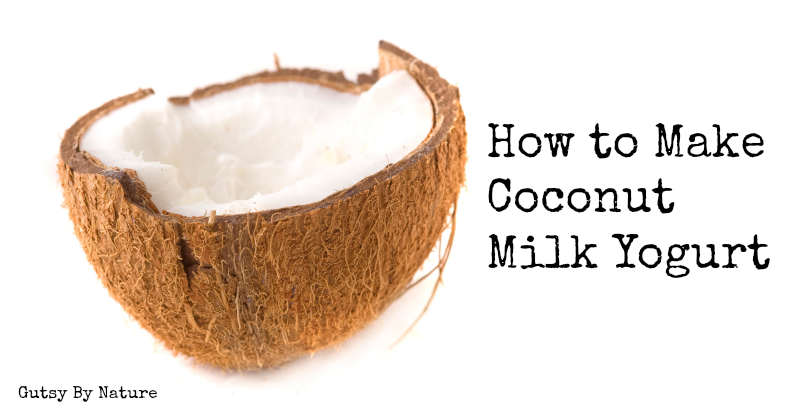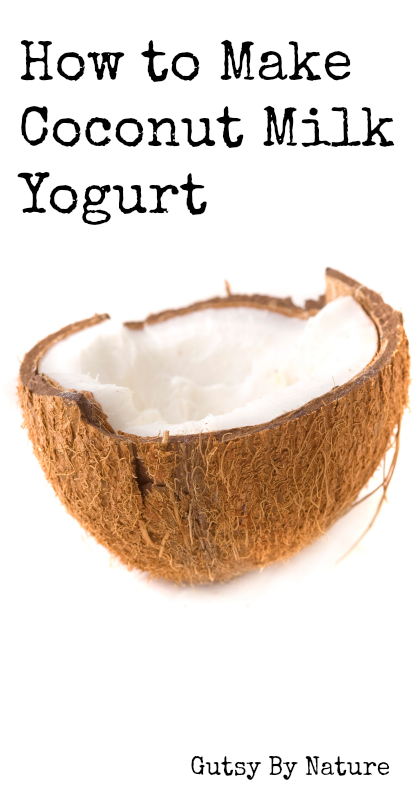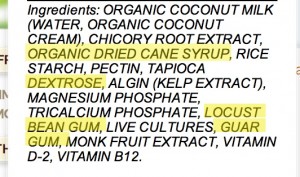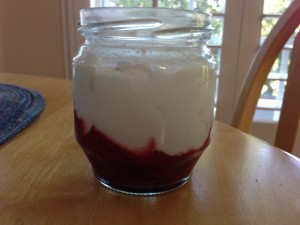 Homemade coconut milk yogurt is a finicky beast. It doesn’t thicken like dairy yogurts, the texture can be less than appealing, and it often lacks the distinctive yogurt tang. Store bought options are more pleasant and consistent, but even the “good” organic brands like this one are still full of added sugars and gums that I try to avoid.
Homemade coconut milk yogurt is a finicky beast. It doesn’t thicken like dairy yogurts, the texture can be less than appealing, and it often lacks the distinctive yogurt tang. Store bought options are more pleasant and consistent, but even the “good” organic brands like this one are still full of added sugars and gums that I try to avoid.
Almond milk yogurt is said to be easier to create at home, but I am currently avoiding nuts as well as dairy as part of a paleo autoimmune protocol. For quite a while I just went without yogurt. But I have a cupboard full of fruit preserves that I put up this summer and know would be delicious mixed into some creamy yogurt and was determined to crack this (coco)nut!
So it has taken some trial and error, but I think I have finally created a recipe and procedure that creates a consistently delicious coconut milk yogurt with the texture of the real thing.
Do I need any special equipment?
I use a yogurt maker (this is the brand I have – I like it because I can make it either in a large mason jar or in small individual jars) but you can make yogurt by placing your jar of yogurt in an oven with the pilot light on, in an insulated cooler filled with hot water (that’s what I did for a long time), in a slow cooker, or even placing the jar on a heating pad and wrapping the whole thing up with a towel. The key is to be able to keep the yogurt during the fermentation period somewhere between 108 and 112 degrees. Obviously, the yogurt maker automates this and takes the guesswork out of the whole process, but other methods will produce results that are just as good.
How long does it take?
I won’t lie. Coconut yogurt takes a long time to make. To get a true tangy taste I have found that I need to ferment it for about 24 hours and then you need another 6-8 hours for it to chill and set up in the refrigerator. What I do is start two days before when I expect to eat it. I put the yogurt in the yogurt maker in the evening on day 1 and let it ferment for the next 24 hours. In the evening on day 2, I transfer the yogurt to the refrigerator and let it chill overnight so it is ready to eat for breakfast on the morning on day 3.
What kind of starter should I use?
If you are very sensitive to dairy protein, you’ll want to get a vegan starter. I recently discovered this brand at my local health food store.
If you can tolerate small amounts of dairy protein then any thermophilic starter will work just fine. Remember that if you are following the Specific Carbohydrate Diet you want to choose one that does NOT include bifidus strains. This brand (which I can also find at my local health food store) is one of the few that I know of that is SCD legal.
What kind of coconut milk should I use?
Use a full fat milk and look for a brand that does not include additives and is in a BPA-free can. I use this brand .
Why does your recipe include gelatin?
Coconut yogurt simply will not thicken up like dairy yogurt, so you need to add a thickener. Some recipes call for tapioca starch or even pectin – especially if they are developed by vegans who eat no animal products, but I like using gelatin for the additional health benefits. You can use regular unflavored gelatin from the supermarket, but I prefer this brand because it comes from grassfed cows.
How do I make it?
I thought you’d never ask! Here is the recipe:
Print
Coconut Milk Yogurt
- Total Time: 36 hours
- Yield: 8 1x
Description
Non dairy yogurt that tastes as good as the real thing!
Ingredients
- 2 13.5 ounce cans of full fat coconut milk
- 1 teaspoon gelatin
- one packet of yogurt starter
Instructions
- Heat the coconut milk in a small saucepan to 115 degrees farenheit.
- Remove from heat and sprinkle the gelatin into the milk and mix well.
- Allow the milk to cool to 110 degress, then add the yogurt starter and mix well.
- Transfer milk to a jar or to the yogurt maker, depending on the technique you are using.
- Incubate the milk for 24 hours, keeping the temperature between 108 and 112 degrees. During this time, the milk will separate and if you are fermenting in a clear container you will see clear liquid on the bottom. This is normal, do not be concerned.
- After 24 hours the milk will have a yogurt taste and will have thickened somewhat but will still be fairly thin. Use a spoon to mix the yogurt up and then place it in the refrigerator for at least 6 hours. This halts the fermentation process and allows it to thicken.
- Cook Time: 36 hours
- Category: yogurt
Please sign up for my weekly email newsletter to be the first to know about all my latest offerings and news!
Click to Pin It!

For more great yogurt recipes and tips
- How to Make Your Own Yogurt (The Nourishing Cook)
- How to Make Yogurt in a Mason Jar (The Prairie Homestead)
- Paleo Yogurt Pots (Meatified)
- How To Make Your Own Greek Yogurt (Oh Lardy!)
Looking for even more recipes? Check out this Fermentation Recipe Collection from Cheerfully Imperfect.

This article was shared on Make Your Own Monday, Party Wave Wednesday, Real Food Wednesday, Thank Your Body Thursday, Tasty Traditions, Pennywise Platter Thursday, Simple Lives Thursday, Paleo AIP Recipe Roundtable.





28 replies on “Adventures in Fermentation: Coconut Milk Yogurt”
Hi 🙂 I made my first batch of coconut milk yogurt yesterday and pulled it from the incubator this morning. I used a yogurt maker. The tops on the yogurts had little dark spots, is that normal? I may be a bit paranoid that I grew bad bacteria along with the good. I have a picture but I just can’t upload it here. Any advice would be greatly appreciated. TIA
Hi Dawn,
The black spots could be mold. If you can spoon them out and they are not riddling the entire surface of the yogurt it should be fine once you refrigerate it. Important to get the spores out before they get a hold of the culture though, but once refrigerated it should be fine. If the yogurt still has black spots after refrigeration, I would ditch it and start again. Keep your utensils and containers sterile as possible by at least rinsing them in a vinegar wash or hot water. Good Luck
[…] Adventures in Fermentation: Coconut Milk Yogurt – Gutsy By Nature […]
Hi, I ordered the coconut milk and gelatin you recommended and am eager to try this recipe since I can no longer tolerate scd legal goat’s milk yogurt. I found “Let’s do organic” organic creamed coconut and was thinking of adding a teaspoon to the recipe. What do you think? And, at what point in the recipe should I try it? I was thinking of adding it at the end, after fermentation and refrigeration since it will thicken the batch. Or, do you think i should add it before fermentation? Or, at all? It seems to be scd legal which is why I thought I’d add it for thickening. Looking forward to your opinion. thanks!
I think that adding the creamed coconut would work… I would probably try adding it at the end. Let me know what happens!
Hi! I can’t wait to try this recipe out. I’m wondering can I use homemade coconut milk in place of canned? Would the fat content be different? Thank you!
I haven’t tried, but I think that would work. Let me know how it turns out!
Hi, the coconut yogurt came out pretty good -well it smells and looks good, I haven’t tried it yet. It is watery as expected, but it has several hard, large pieces in it. They look like 1/2 circle white chocolate- or picture the wax at the bottom of a candle that burned down:) Is that because the gelatin didn’t mix well? Is it still OK to eat? I’m recovering from a flare and the goat’s milk scd yogurt isn’t tolerated yet. I didn’t add the “Let’s do organic” organic creamed coconut in this batch. You said add at the end but weren’t specific, so I wasn’t sure. Could you elaborate? Did you mean at the end of heating? Or, at the end like the last hour of fermentation? Or, at the end- like when I’m about to eat it? Thanks!
I so wanted this to work! What a disaster……not even close to being thick even after beating/whipping to combine. I do not think 1 tsp is enough, maybe 1 Tbsp. Beyond saving, so expensive waste… 🙁 bummer.
Guess I will try the goat milk yogurt again.
I have the GI prostart yogurt starter, how much should I use? As it isn’t in packets…
[…] and buttermilk Coconut Milk Yogurt Ingredients you will need: Coconut milk gelatin, quality grass fed Starter […]
[…] creamy tang that comes from my beloved and much missed sour cream. I toyed with the idea of making AIP yogurt and thickening it, but I didn’t have the time or patience to wait for that, so I began […]
Hi, thank you for sharing this recipe. I tried numerous others before this one and it has been perfect. This may have already been covered but I am struggling to find it and just wanted to clarify about the shelf life of this yoghurt once refrigerated.
thanks in advance, Laura
Hi there,
Thanks for sharing this recipe! I’m excited to try it. Instead of using a yogurt starter, can you use a coconut yogurt (ie cocoyo by GTs) or probiotic capsules? Thanks, Anna
Anna,
I usually use probiotic capsules, but this last batch I used 2 tablespoons of Cocoyo in a batch of that called for 2 cups of coconut milk. It turned out great! It’s much more “alive” than using the probiotic capsules.
Kathleen
Thank you, Kathleen! I was wondering that just now and found your reply. Did you follow all the other instructions as written and added 2 Tbsp. in place of the starter at the same time the starter would be added?
[…] to try:Instant Pot Coconut YogurtCoconut Milk YogurtHow to Make Creamy Coconut Milk Yogurt (No Yogurt Maker […]
Hi there! Is there a typo in your post? Most yogurt recipes are heated to 185 so I was just checking. Thanks!
Not a typo! It isn’t necessary to heat coconut milk as high as you do regular cows milk (or any other animal milk) because we don’t need to sterilize it or denature the proteins. All you need to do is get it just above the incubating temperature. Thanks for asking!
[…] Instant Pot Coconut Milk Yogurt @ Sweet Treats • Honey Jun Soda @ Forest and Fauna • Coconut Milk Yogurt @ Gutsy By Nature • Cinnamon Coconut Water Kefir @ A Harmony Healing • Basic Kombucha @ Gutsy […]
[…] negatives nor positives in her diet, and replaces them with healing foods instead, like liver, fermented foods, bone broth, and a wide variety of vegetables. She also tries to stay tuned into her body, catching […]
[…] Keep your fermented foods going this fall with this delicious fermented pineapple ginger soda, fermented coconut yogurt, and keep ear infections at bay with this homemade garlic oil. My skin has been acting […]
Hi, wanted to try this recipe, but am curious of how long it lasts? Is is like standard yogurt that will last several days in the fridge? Thank you !!
Yes, just like standard yogurt. The cultures do a good job of stabilizing it, but anything will get moldy eventually.
Thank you for pointing out that “During this time, the milk will separate and if you are fermenting in a clear container you will see clear liquid on the bottom. This is normal, do not be concerned.”
I was about to doubt my yogurt!
Also, have you ever added some sugar to help the fermentation process. What are your thoughts on that.
After we fermented the yogurt it had separated, and we mixed it then put it in the fridge, and during that time it separate again. It appears that only the top layer is yogurt, and the bottom layer is water.
When you refrigerate, does your yogurt not separate?
It separates… you just need to stir it up again!
Do you know what the the bloom strength of the Great Lakes Wellness Culinary Beef Gelatin Powder you recommend is?